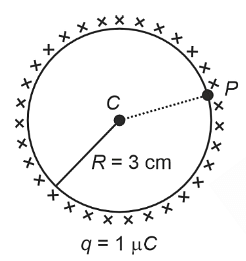Question
Physics Question on Electric Potential And Potential Difference
A thin spherical shell is charged by some source. The potential difference between the two points C and P (in V) shown in the figure is:
(Take \frac{1}{4}\pi\epsilon_0 = 9 × 109$$\frac{1}{4\pi\epsilon_0}=9\times10^9 SI units)

3 × 105
1 × 105
0.5 × 105
Zero
Zero
Solution
A charged spherical shell has the same potential at all points inside the shell and on its surface.
This property arises because the electric field inside the shell is zero.
- The potential V at any point inside the shell (including the center C) and on the surface P is given by:
V=4πϵ01⋅Rq,
where
q=1μC=1×10−6C,
R=3cm=0.03m, and
4πϵ01=9×109SIunits.
- Since the potential V is the same at both points C and P,
the potential difference ΔV=VP−VC=0.
Thus, the potential difference between C and P is Zero.
